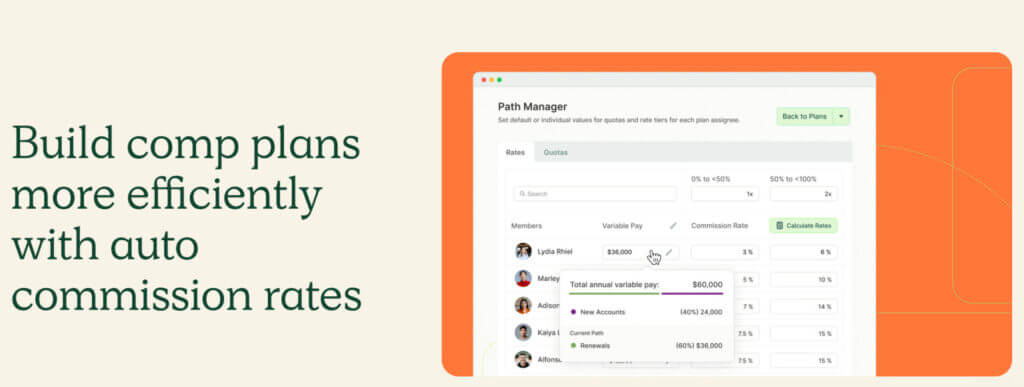People often ask us about commission rates. What should the commission rate be for a CS? What about an AE? How does this change with the compensation plan? Our goal with this article is to address these questions.
The common SaaS sales compensation plan consists of:
- Base salary that’s 50% of on-target earnings (OTE)
- Quarterly quota period
- Quota based on ARP and 4-7x OTE
- Accelerators and decelerators as key components
Source: Sales compensation trends to know in 2023
Although the standard commission rate for SaaS sales is historically 10%, this rate varies by role and has been adjusted for specific roles over the last year due to market conditions.
Streamline commissions for your RevOps, Finance, and Sales teams
Design, track, and manage variable incentives with QuotaPath. Give your RevOps, finance, and sales teams transparency into sales compensation.
Talk to SalesFor many companies, retention is now more or equally important than a new business, so commission rates for account managers and customer success managers (CS) teams have increased accordingly.
Below, we’ll go through how to set commission rates and rates by role.
Terms to know
Single rate commission: Also known as flat or fixed rate commissions, single rate commission means a salesperson earns the same percentage off the deals they close.
Accelerator: A sales accelerator rewards a salesperson for exceeding designated targets or goals. It is often awarded in the form of an additional bonus or incentive.
Cliffs or commission floors: A commission floor or cliff is a threshold that must be met before a salesperson can earn a commission. This element is often used to protect the business from compensating reps for mediocre performance while motivating the sales team to achieve designated milestones.
Decelerators: A decelerator is a lower sales commission rate that reduces earnings based on specific criteria. It can be used to discourage reps from closing less profitable deals or those less favorable to the business.
Bonuses: A bonus rewards earned by sales reps who meet or exceed established targets, whereas commissions are paid as a percentage of the value of deals closed. There are various types of bonuses including ranking, year-to-date, and milestone bonuses, and bonuses on multiple quotas.
Accelerators with multipliers: Accelerators with multipliers incorporate various rates that are multiplied by specific criteria to reward desirable sales behavior. For example, 10% earned on 1-year deals, 15% on 2-year deals, and 20% on 3-year deals.
How to set commission rates
How do you determine commission rates? It’s a straightforward calculation once you’ve established your on-target earnings (OTE) and quota.
For example, consider a 10% single-rate commission for an OTE of $120K, divided into a $60K base salary and $60K commission, plus a $50K/month quota. That works out to $60,000 annual commission / 12 months = $5,000 OTE per month. Then, $5,000 OTE per month / $50,000 quota per month = 10% commission.
Another way to approach the same scenario is to reward overperformance by offering an accelerator for reps exceeding 100% of their quota. We recommend accelerators that apply to monthly sales as an additional incentive. For example, your reps can earn 10% of their sales up to quota and 12% for all their sales when they meet or exceed quota. You can include multiple earnings tiers when implementing this option, but we recommend limiting it to no more than four tiers.
A milestone bonus for attaining a monthly quota is another possibility. This encourages consistent sales performance month after month. One way to implement this is by offering a $1,000 bonus for reps that hit their monthly quota and decreasing the commission rate to 8% while keeping OTE the same.
Ultimately, you must fiddle with the numbers until you determine what works best for your organization.
And, if you need a simple and effective first compensation plan, you might consider this plan by our CEO, AJ Bruno.

Commission rates by role
Commission rates vary by role, with sales reps typically earning the highest percentage from their sales and account managers, sales development reps, and sales directors receiving less. But, as we mentioned previously, this has changed a bit over the last year due to economic and market conditions.
Let’s review some commission rates by role.
Account executive: The typical commission rate on sales for an AE is usually 10%. Most sales incentive plans include accelerators to encourage and reward overperformance. This AE comp plan example and template depicts this scenario.
Sales development rep: SDR commission rates commonly fall between 2% and 5% if they earn a percentage from deals that close from leads the SDR generated. This arrangement is called the Closed Won Commission model.

Account manager: It used to be that an AM typically earned a commission rate of 5% on upsells, but they’ve risen to as much as 10%. Organizations shifting from a “grow at all costs” mentality to a “predictable revenue model” has influenced this change. Here are 3 commission pay examples for Account Management & Customer Success and account manager compensation plan templates.
Sales Director: Sales directors typically earn a commission for every deal their team members close. Commission rates paid to sales directors tend to be between 3% and 5%. Check out this blog for sales manager and sales director compensation plan examples.
Set commission rates to achieve business goals
The SaaS sales commission rate is typically 10% and varies by role as well as market conditions to incentivize sales rep behaviors that help the business achieve its goals.
Although a simple calculation can determine commission rates once you have set OTE and quota, there are multiple ways to approach this process. So, it’s advantageous to experiment with the figures to find the best method for your specific business.
For additional support in setting commission rates, use the following free resources:
Then, sign up for a free trial to automate commission tracking and calculation.



